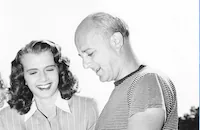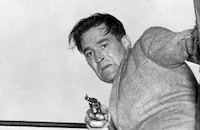Man in the Dark

Brief Synopsis
Cast & Crew
Lew Landers
Edmond O'brien
Audrey Totter
Ted De Corsia
Horace Mcmahon
Nick Dennis
Film Details
Technical Specs

Synopsis
Steve Rawley, a criminal serving a ten-year sentence for the theft of a $130,000 company payroll, is paroled after one year to Dr. Marston as a volunteer for experimental brain surgery. The surgery is successful, but leaves Steve with complete amnesia. Under the name of James Brooks, Steve recuperates slowly, believing he is recovering from an automobile accident. Dr. Marston tells visiting insurance investigator Jawald, who is assigned to track down the payroll money, that Steve should lead a productive law-abiding life, but Jawald is skeptical of Steve's amnesia. When Steve is almost fully recovered, members of his old gang, Lefty, Arnie and Cookie, kidnap him from the clinic grounds, anxious to retrieve the stolen money. At their hideout near an amusement park, Steve insists he is not Rawley, even when greeted with affection by his old girl friend, Peg Benedict, whom he does not recognize. After Steve hears a radio bulletin describing his abduction as a criminal escape, he grows uncertain, but continues to maintain his ignorance of the factory heist. Peg speaks with Steve alone, imploring him to be honest with her and confess the location of the money. She grows angry when Steve continues to disclaim any knowledge. Later that evening, Steve tries to telephone for help but is caught and beaten by Lefty and Arnie until Peg intervenes. Lefty shows Steve newspaper clippings of the robbery and describes the events of a year earlier: Steve plans every detail of the robbery, choosing Christmas Eve as the date because he knows there will be a cash bonus for the factory employees. After the theft, Steve escapes with the money while Lefty and the others hold off the police. Later when telephoning the gang, Steve panics upon seeing the police and is chased across the city rooftops before being captured. Lefty visits Steve monthly in prison, hoping to learn the location of the money, but Steve, suspicious about the relationship between Lefty and Peg, refuses to tell. In the present, Steve insists the details have triggered no recollections. Arnie, however, suddenly recalls that Steve wore a dark suit during the robbery, yet the newspaper photo at the arrest shows him in a light suit. Suspecting that Steve must have gone home and perhaps left the money there, the gang heads for his old house, now abandoned and up for sale. Peg, who has come to believe Steve is telling the truth, goes to a bar, where she laments with the bartender about still being in love with Steve. When Peg leaves, Jawald, who has been following her, asks the bartender for Peg's address. At Steve's old house, meanwhile, the gang breaks in and rummages about. Steve finds a small piece of paper with a number on it, but it provokes no memories. Steve then tries to escape but is recaptured and returned to the hideout, where Lefty wonders if the numbers are part of a combination. When Steve provides no answer, Lefty loses patience and has Arnie and Cookie beat him. Meanwhile, Jawald follows Peg to the apartment and watches the building with his partner. Later, Dr. Marston visits Jawald and warns him of Steve's fragile condition, but Jawald remains skeptical, convinced that Steve is shamming and will eventually lead him to the money. Back at the hideout, Peg tends to Steve who, in a semi-conscious state, has an unusual dream set at the amusement park, involving the police, Peg and a box of chocolates. Steve awakens distraught and Peg comforts him. A few days later, with Jawald still watching the apartment, Lefty offers Steve fifty percent of the money if he will finally reveal its location. Frustrated and angry, Steve reacts violently, then wonders with Peg if he is reverting to his old ways. Peg entreats Steve to remain the man that he has become and not allow the situation to change him. Steve and Peg escape and after following one false lead, Steve wonders about his dream and goes to the nearby amusement park pier, followed by the gang and Jawald. As Steve retraces the steps of his dream, he finds himself at a small package check counter and realizes the numbered paper is a claim check. His hopes are dashed, however, when the proprietor reveals that items are only held for sixty days. Steve asks to look in the back and high on a top shelf discovers a chocolate box with the matching number on it. Excited about finding the money, Steve determines to keep it, but Peg tells him she will not remain with him if he does. Meanwhile, Lefty and the others close in and Steve bolts with the box, jumping onto the roller coaster and jumping off at the top of the ride. Lefty follows and the two fight on the rafters until Lefty falls into the path of an oncoming car and is killed. Arnie continues chasing Steve, but is shot by the police, who were summoned by Jawald. Steve considers escaping with the money, but upon seeing Peg, decides to turn the money over to Jawald instead and try for a new life.

Director

Lew Landers
Cast

Edmond O'brien

Audrey Totter

Ted De Corsia
Horace Mcmahon

Nick Dennis
Dayton Lummis
Dan Riss
Shepard Menken
John Harmon
Ruth Warren
Crew
Henry Altimus
George Bricker
Floyd Crosby
Lodge Cunningham
Ross Dimaggio
Viola Lawrence
Jack Leonard
Wallace Macdonald
John Meehan
Irving Moore
Robert Priestley
William Sackheim
Tom Van Dycke

Film Details
Technical Specs

Articles
Man in the Dark on 3-D Blu-ray!
A remake of the 1936 crime melodrama The Man Who Lived Twice, this version takes the story of amnesia into urban noir territory. O'Brien spouts tough-guy wisecracks until he emerges a kinder, gentler soul (he turns to painting flowers during his recovery), Ted de Corsia does thug duty as the gang's heavy (Horace McMahon and Nick Dennis, the va-va-voom mechanic of Kiss Me Deadly, fill out the crew), and the investigator turns out to be a mercenary soul in his own right. When he finds out where the gang is stashing Rawley, he doesn't bother alerting the hospital or the cops, he just stakes out the place in hopes that they'll eventually lead him to the stolen loot. The brutal treatment that Rawley endures is just collateral damage.
Audrey Totter, one of noir's most distinctive dames, enters the film in hard-bitten schemer mode but as she becomes convinced of Rawley's transformation, she softens as she falls for a good guy for a change. O'Brien does a nice job of transforming from a snarling thug to a simple, ordinary guy who is confronted with the evidence of his past, forgotten life as a criminal, and he effectively lets us see his sense of self crumble under the beatings doled out by the gang. The nightmarish dream sequence is both a flashback to a life he can't remember and a puzzle with clues to the scavenger hunt for the hidden loot, and it gives the film its defining noir sensibility: a man paying for crimes he can't recall, brutalized by partners holding a grudge, and imprisoned in a situation he can't escape. It's also a prime opportunity to show off the film's at-the-time unusual gimmick: 3D.
This 1953 production is a true oddity. Not only is it the only 3D film noir, it beat House of Wax to the theaters (by two days!) to become the first 3D feature released by one of the major studios. Not that Columbia put any budget behind the film. B-movie veteran Lew Landers, who spent years cranking out second features for Columbia Pictures, was drafted to direct and given a budget that looks starved compared to Columbia's standard fare but is lavish by the standards of his earlier eight-day wonders. (According to film historian Julie Kirgo in the accompanying essay, this film was shot in 11 days.)
As noir goes, this is light on the visual style--not a lot of dark alleys or shards of light slashing through the shadows, and most of the Los Angeles streets scenes are shot in the bright light of day--and much of the film is cooped up in a crummy apartment done up in basic blah. What Landers brings to the film is a tough efficiency, getting to the point quickly and sketching in the mercenary reality of Rawley's new situation in harsh lines. Finally the film breaks out of the apartment and onto a carnival midway. The bustle of crowds and the bric-a-brac of the sideshow attractions (including a gargoylish dummy laughing at the bitter comedy of it all) crammed into the frame give the film some energy and the action spills out into a nighttime location shoot, where a chase winds up scrambling over the wooden beam latticework holding up a rollercoaster. This is where the shadows start to loom over the film. Landers applies the tricks that every early 3D filmmaker used, starting with the POV of the surgical instruments jabbing through the screen as Rawley goes under for surgery. The most mundane objects are turned into weapons of distraction for 3D but it really gets its workout in the dream sequence, the carnival scenes, the fairground rides, and of course the rollercoaster.
The film was digitally mastered in 4K for 3D Digital theatrical showings, making its restoration debut of Noir City in San Francisco in early 2013 and subsequently touring in select showings around the country, where I was first introduced to the film. Twilight Time's disc offers both standard and 3D editions of the film, the company's first 3D release, but you need a full HD 3D compatible TV, 3D glasses, and a Blu-ray 3D player for the latter. On a standard Blu-ray player, the 3D version doesn't even appear on the menu. The image looks superb, showing off the restoration to its best and reminding viewers how great a well-mastered black-and-white film can look in Blu-ray, even a relatively cheap production like this. You don't need the 3D to get the punch of this noir, but the garish dimensional effects are fun and the digital translation is very good, from the standard clichés of objects jumping out of the screen to the depth of field in the rollercoaster climax. The disc also features Twilight Time's trademark isolated musical score and an eight-page booklet with an essay by Julie Kirgo. Limited to 3000 copies, available exclusively from Screen Archives and TCM.
By Sean Axmaker

Man in the Dark on 3-D Blu-ray!
Quotes
Trivia
Notes
The working title of the film was The Man Who Lived Twice. Although reviews refer to the operation that character "Steve Rawley" undergoes as a lobotomy, the procedure is not referred to specifically in the film. Man in the Dark was the first Columbia production to use the 3-D format, which, according to a March 1953 Variety news item, was developed secretly in the studio lab. The news item further noted that the process required "two cameras, but no mirrors" and was "simple, light and mobile." Information in the copyright record indicates that Man in the Dark was released in sepia, but the print viewed was in standard format and black and white.

Miscellaneous Notes
Released in United States Spring April 1953
Remake of "The Man Who Lived Twice" (1936) starring Ralph Bellamy.
First film to be released in 3-D by a major studio.
3-D
Released in United States Spring April 1953













